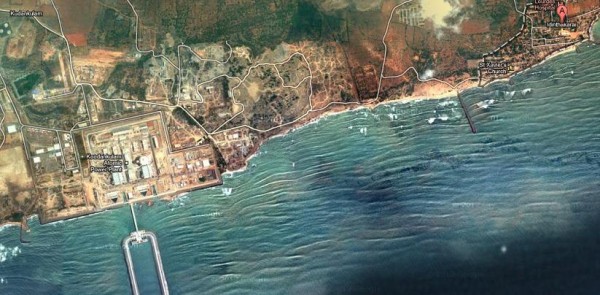The Kudankulam Nuclear Power Project (KKNPP) in the Tirunelveli district of Tamil Nadu, India, started operations recently despite demands to stall it. In recent months the police had cracked down on several protests (see Global Voices report) of activists and inhabitants of nearby villages against this plant.
The ‘People’s Movement Against Nuclear Energy’ (PMANE) activists fear that this nuclear power plant is prone to an accident similar to the radiation leak at the Japanese coastal nuclear plant last year.
The latest Court rulings enabled commissioning of Units I and II of the nuclear plant. Karthik Ganesh at Youth Ki Awaaz notes that safety recommendations were not adhered to:
In spite of all the clearances from the High Court, the state government is yet to ascertain an escape route for the inhabitants living in and around the nuclear plant, prepare a plan to decommission the power plant post its life span and formulate a detailed analysis of a disaster scenario in agreement with the international standards.

The proximity of Idinthakarai, and nearby villages to the Koodankulam nuclear power plant at the Indian Ocean. Image courtesy Google maps
On Sunday morning [9 September, 2012] protestors from eight villages near the plant assembled at the beach and stood in sea water to protest moves to load uranium fuel in one of the two reactors.
Nityanand Jayaraman reports in Dianuke.org:
Responding to the Atomic Energy Regulatory Board’s clearance to commence nuclear fuel loading in the Koodankulam plant, the People’s Movement Against Nuclear Energy announced that protestors would lay siege to the plant on 9 September. Police force was deployed in huge numbers in the area. On that day, between 8000 and 10000 people, including children and women from Idinthakarai and neighboring villages started from the Lourde Matha church in Idinthakarai. They walked down the coastal path avoiding the road route and were stopped by the police around 800 metres away from the plant. The protesters sat down on the sea shore and said they will continue their struggle from there.
On the morning of the 10 September, the police came in with the strike force and fired tear gas and used batons to disperse thousands of protestors causing some of them them to flee to the sea in boats. The police atrocity was caught on camera and uploaded to the Dianuke.org site. Many people including some from media covering the incident were injured. Hundreds of villagers were arrested.

Thousands of villagers protesting at the beach. Image by Anthony kebiston Ferando, courtesy Dianuke.org
On 11 September a 44 year old fisherman was killed by police in Tuticorin as the protests turned violent. Around 4,000 security personnel, including the Rapid Action Force, have been deployed in the area.
First Post reports that on September 13, the Supreme Court has refused to halt the loading of fuel rods in one of the two reactors of the Koodankulam nuclear power plant, but they have agreed to examine the risk associated to the project and consider peoples’ safety.
Suvrat Raju, a physicist, provides a brief summary of the issues involved:
1) The local residents of the region have never been consulted or taken into confidence about the project.
[..]9) The Government has signed a secret “liability” agreement with Russia completely indemnifying the Russian company in the event of an accident.
A discussion thread in the First Post shows divided opinions of netizens on this issue:
G_PramodKumar: The protestors in Koodankulam may be justified in their safety fears, but they offer no space for negotiations because their single-point agenda is to close the plant. Other demands are certainly red herrings. This is unreasonable mainly because it came rather too late in the day. The foundation stone of the plant was laid a decade ago and the protestors should have stalled it either then or before that.
hummmingbird: Protestors are not well informed and being exploited by interested parties towards achieving their own selfish goals.
hema: Many of the developed countries are rethinking on their nuclear policy. Why can't we learn from others’ experiences.
Durga_Raghunath: Every citizen has the legal right to know how his health and his environment are being affected. Neither the officials running Koodankulam nor the government has shared with the people of Idinthakarai the right kinds of accessible information that would give them confidence of their safety. It really leaves them with little choice.
bud: If India has to progress we have to take some risks. This is one of them.
Here are more Twitter reactions:
@peninthepond: 7,000 people in Koodankulam face sedition charges. Are we moving towards fascism? http://t.co/v0u37KNN
@DiaNuke_org: Another death in Koodankulam: Mr. Sahayam from Idinthakarai, who was standing in Line Curve bridge and… http://t.co/UT6cTobR
@boazbchacko: #Koodankulam. It's not fair a democratic govt. waging war against its own people. Trust of the civil society of #idinthakarai to be gained.








12 comments
Jayalalitha should be prosecuted for having murdered a fisherman. She has utterly and miserably failed to administer the government.
She should be asked to step down now. She has not find alternative method to solve the electricity problem by installing wind power and solar power.
When the state is reeling under electricity shortage she is going out to take rest.
KOODAMKULAM IS HARDLY 100 KM FROM TRIVANDRUM AND WITHIN 25 KM FROM KANYAKUMARI. IT IS A BIG THREAT FOR KERALA. PEOPLE OF KERALA
NEED TO RETALIATE WITH OPTIMUM FORCE.
she did provide an alternate method, sad that people are ludites and are afraid of new technology, and screwing the rest of us in progress, hundreds of nuclear power plants if not thousands operate throught the world, yet people protest on 0 rational grounds, even when abdul kalam said it was good and safe people are still protesting, government cannot give power when they do not have it , these are not nuclear physicists on the ground protesting, they are village fisher men , hence their arguments are not credible. you cant call something wrong without knowing what it is.